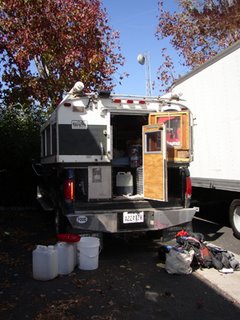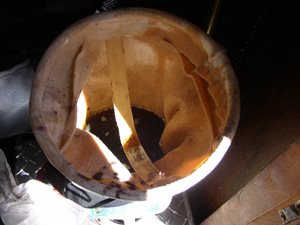 Biggreentruck has been hanging out behind a business park warehouse for a couple of weeks. That's the natty life- you work from home (where the vehicle is parked) unless you're driving a cube truck.
Biggreentruck has been hanging out behind a business park warehouse for a couple of weeks. That's the natty life- you work from home (where the vehicle is parked) unless you're driving a cube truck.The oil supply adventures continue. We canvassed the regular haunts on Seaward with no luck. Then a gaggle of natties went karoke-ing at the Golden China. Jackpot! Jerry was glad to let me scoop from the dumpster even though the cooks didn't believe veggie oil would really power a truck. I filled my cubies-about 18 gals of nice looking oil- and plan to go back for more. Karoke is still weird.
The current filtering system is working out pretty well--Greasecar mistakenly sent 1 micron bag filters (I ordered 5 micron). The finer mesh means filtering takes a little longer but it will prolong the life of the engine filter. The hi-tech funnel (an upside down gallon water jug with the bottom cut off) now has a retaining strap to prevent acccidental spills. And, the southern California sun gently warms the oil in the cubies so it flows nicely.
 The process is still time consuming but is getting easier and less messy with every fill-up.
The process is still time consuming but is getting easier and less messy with every fill-up.